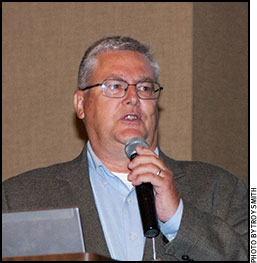Herd Health Affects Reproduction
Veterinarian addresses emerging disease concerns that affect reproductive efficiency.
 For conscientious cow-calf producers, an important part of any herd health program is managing risk associated with reproductive diseases — those that threaten establishment and maintenance of pregnancy and may hinder fertility. In a presentation delivered during the Applied Reproductive Strategies in Beef Cattle (ARSBC) symposium Aug. 29-30 in Manhattan, Kan., Kansas State University veterinarian Gregg Hanzlicek discussed some of the more prominent diseases responsible for abortion and low fertility.
For conscientious cow-calf producers, an important part of any herd health program is managing risk associated with reproductive diseases — those that threaten establishment and maintenance of pregnancy and may hinder fertility. In a presentation delivered during the Applied Reproductive Strategies in Beef Cattle (ARSBC) symposium Aug. 29-30 in Manhattan, Kan., Kansas State University veterinarian Gregg Hanzlicek discussed some of the more prominent diseases responsible for abortion and low fertility.
Hanzlicek said many producers are familiar with campylobacter (vibriosis) and leptospirosis, which are contagious bacterial diseases commonly known to be responsible for abortions in cattle. While they may be aware of anaplasmosis, producers may not know that this bacterial infection can affect reproduction.

Kansas State University veterinarian Gregg Hanzlicek discussed some of the more prominent diseases responsible for abortion and low fertility.
“Anaplasma infection typically is not a fertility issue,” said Hanzlicek, allowing that it is possible, however, for the infection to result in late-term abortions or stillborn calves.
“Cows can become so anemic that not enough oxygen reaches the fetus, which dies,” Hanzlicek explained. “Or, the organism may be transmitted to the fetus, which typically results in abortion.”
Referring to the recent availability of what he called “an experimental vaccine,” Hanzlicek said reports suggest the product helps reduce the clinical signs of anaplasmosis, but it is not effective as a preventative to infection.
“Guys that use it like it,” stated Hanzlicek.
Kansas State University Diagnostic Laboratory data show a steady increase, since 2014, in abortion cases associated with infectious bovine rhinotracheitis (IBR). Many fetuses submitted to the laboratory contained an IBR strain identical to that in modified-live virus (MLV) vaccine.
“I’m not saying ‘Don’t use MLV vaccine,’ but make sure you follow label directions and your veterinarian’s advice,” recommended Hanzlicek.
Like IBR, bovine viral diarrhea (BVD) is a viral disease that can impact reproduction. It’s not just a feedlot disease as many people once believed. Hanzlicek said exposure of bred females to animals persistently infected (PI) or transiently infected (TI) with BVD can lead to early embryonic death, abortion and subsequently reduced fertility.
Hanzlicek also discussed neosporosis, the causative agent of which is a protozoan parasite carried by canines. Dogs, coyotes or wolves become infected by eating neospora-contaminated bovine muscle, placenta or aborted fetus tissues and spread it through the environment via their feces. Pregnant cows or heifers that become infected may suffer early embryonic death or abortion, or they may deliver a live “dummy” calf that appears normal but is a carrier of neospora organisms.
Hanzlicek said other “emerging” diseases with implications for reproduction include bovine leukosis virus and Johne’s disease. He said some evidence suggests zoonotic potential for both, meaning some researchers think each disease may be transmissible to other species, including humans.
Hanzlicek spoke during Wednesday’s ARSBC session focused on systems and health. Visit the Newsroom at www.appliedreprostrategies.com, which features comprehensive coverage of the symposium, to view his PowerPoint or listen to the presentation. Compiled by the Angus Journal editorial team, the site is made possible through sponsorship by the Beef Reproduction Task Force. To access video of the presentations, visit the Beef Reproduction Task Force page on Facebook.
The 2017 ARSBC Symposium was hosted by the Task Force and Kansas State University Research & Extension. Next year’s symposium will be Aug. 29-30 in Ruidoso, N.M.

Editor’s Note: Troy Smith a cattleman and freelance writer from Sargent, Neb.






